Currency
The Canadian dollar has recovered nicely against the US dollar. It continues to move in line with yield spread which is moving now back in favor of Canada. But is it time for a rest before continuing on this path? If we look at the retracement of Wave V into the high, 1.3541 represents a 61.8% retracement; with swing high support coming in at 1.3455. So, not a bad place for some consolidation, recovery, before lower; scope back to 1.4000-level shown as wave 2…that being said, we are getting some risk on again today and oil prices are moving higher…so not something we want to get in front of just yet…next key support level daily basis comes in at 1.3227…
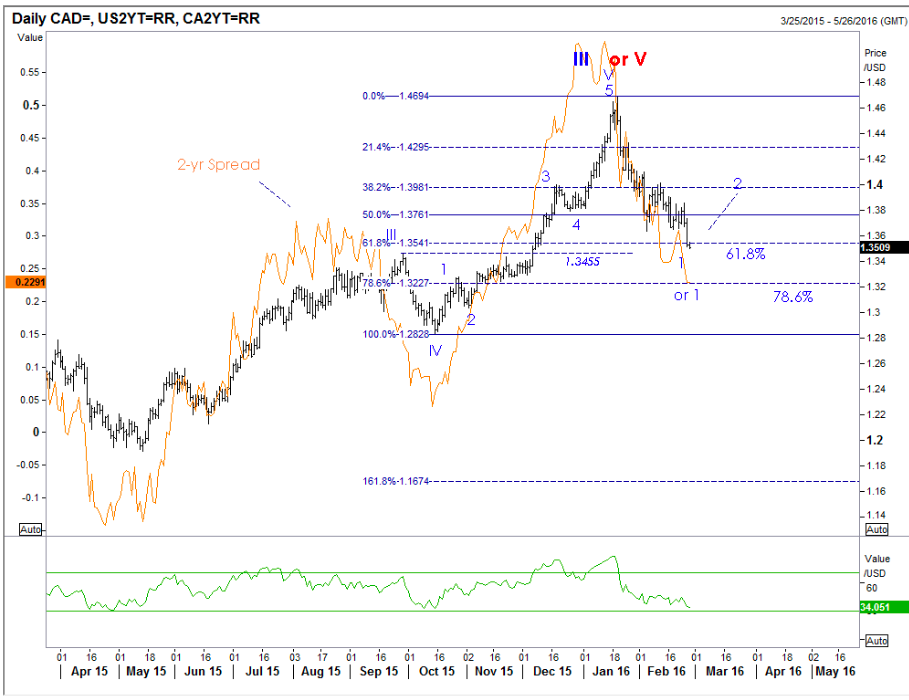
Jack Crooks
Black Swan Capital www.blackswantrading.com
Black Swan Capital’s Black Swan Forex is strictly an informational publication and does not provide personalized or individualized investment or trading advice. Commodity futures and forex trading involves substantial risk of loss and may not be suitable for you. The money you allocate to futures or forex trading should be money that you can afford to lose. www.blackswantrading.com
It appears that Great Britain might actually do the until-recently-unthinkable, and leave the European Union. The reasons for this dramatic break-up are many, and can be Googled easily enough. For our purposes, suffice to say that traders are scrambling to figure out what this means for the British pound, and they’re not liking the answers. Here’s a quick look at the recent foreign exchange action:

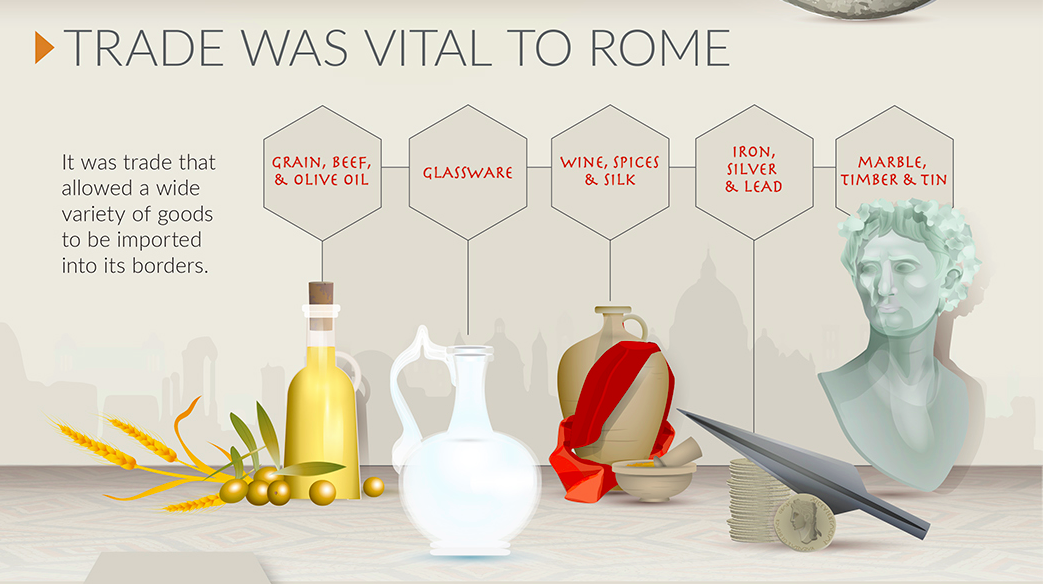 At its peak, the Roman Empire held up to 130 million people over a span of 1.5 million square miles.
At its peak, the Roman Empire held up to 130 million people over a span of 1.5 million square miles.
Rome had conquered much of the known world. The Empire built 50,000 miles of roads, as well as many aqueducts, amphitheatres, and other works that are still in use today.
Our alphabet, calendar, languages, literature, and architecture borrow much from the Romans. Even concepts of Roman justice still stand tall, such as being “innocent until proven guilty”.
How could such a powerful empire collapse?
THE ROMAN ECONOMY
The exchange rate between the Argentina Peso and the US dollar in January 1945 was 4.17 pesos to one dollar. Like the United States, Argentina created substantial price inflation – devaluation of their currency – in the 1950s – 1990s.
According to Wikipedia Argentina devalued their currency by a factor of 100 in 1970, by another 10,000 in 1983, by another 1,000 in 1985, and by another 10,000 in 1992.
From Alan Greenspan in 1966: “In the absence of the gold standard, there is no way to protect savings from confiscation through inflation.”
In summary the 1945 peso was devalued by 10 trillion to one between 1945 and 2015. Imagine what that did to the poor and to the saving of anyone who left that savings or retirement in pesos!
The compounded average rate of increase in the number of pesos per dollar from 1945 to 2015 was about 55% per year, every year. The devaluation was worse than average between 1975 and 1995. Gold in 1945 pesos increased at a compounded average rate of 63% per year since 1945. (Store of value!)
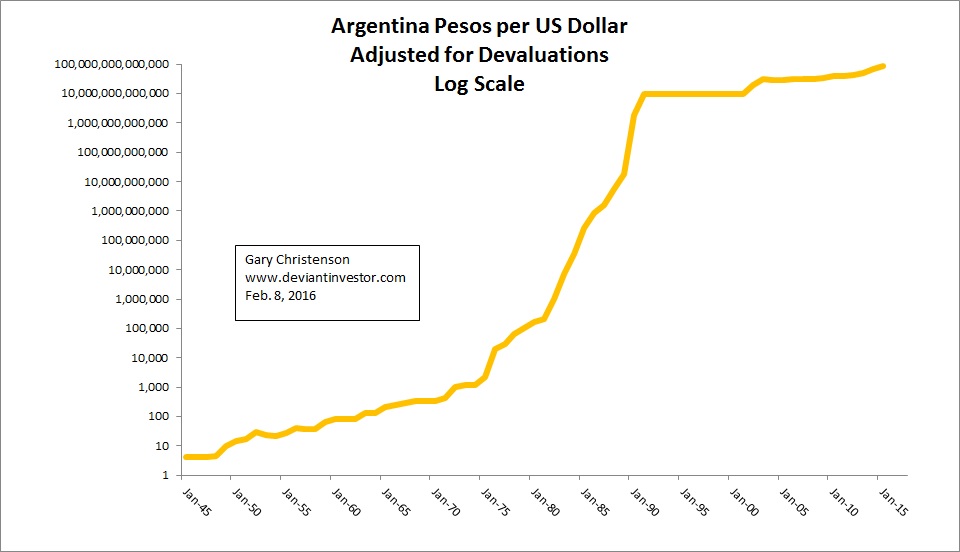
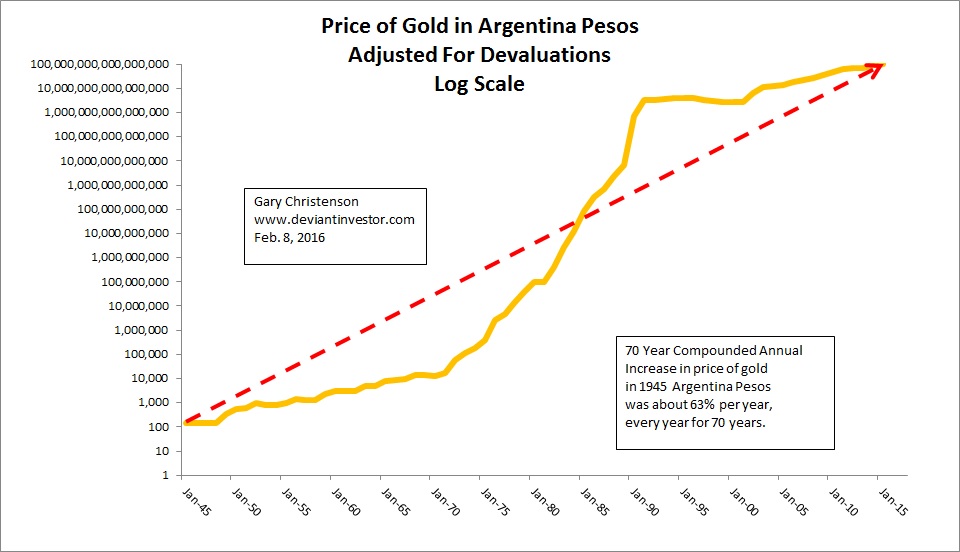
Suppose your savings in Argentina pesos had been valued in gold. Take the peso to dollar exchange rate and multiply by the price of gold in dollars and we see the price of gold in 1945 pesos.THE POINT OF THIS IS:
Argentina devalued their currency from 1950 onward and more aggressively in the 1970s, 1980s and 1990s. The difference between Argentina and the United States (and Japan, the EU, the UK, Australia etc.) is mostly a matter of degree.
The US benefitted from the dollar’s “reserve currency” status plus the US military, but the devaluation process has been similar, though less devastating. In 1971 the US dollar bought approximately 0.03 ounces of gold. By 2015 the US dollar bought less than 0.001 ounces of gold – a devaluation of over 30 to one. More devaluation is coming.
EXPONENTIAL INCREASES HAPPEN HERE:
The global financial system is based on exponentially increasing debt, currency in circulation, and devaluations. Examples:
- Official US national debt: Approximately 9% per year exponential increase since 1913. (Consumer price inflation is alive and well.)
- Gold price increase in US dollars since 1971: Approximately 7.8% per year exponential increase since 1971. (Increases coming soon.)
- Silver price increase in US dollars since 1971: Approximately 5.5% per year exponential increase since 1971. (Big increases coming soon.)
- Shanghai Index from June 2005 to October 2007: Approximately 217% per year exponential increase for 2.3 years.
- Shanghai Index from March 2014 to June 2015: Approximately 216% per year exponential increase for 1.3 years.
- Crude Oil price increase from December 1998 to October 2000: Approximately 196% per year exponential increase for 1.8 years.
- Crude Oil price increase from January 2007 to July 2008: Approximately 203% per year exponential increase for 1.5 years.
- NASDAQ Composite price increase from October 1998 to March 2000: Approximately 257% per year exponential increase for 1.4 years.
- Nikkei Index price increase from July 1984 to December of 1989: Approximately 129% per year exponential increase for 5.4 years.
- Silver price increase from August 1977 to January of 1980: Approximately 276% per year exponential increase for 2.4 years.
- Adjusted US monetary base per Federal Reserve Bank of St. Louis increase from 2008 to January of 2015: Approximately 24% per year exponential increase for 6.5 years.
- Exponential increases have also occurred in student loans, sub-prime auto loans, military expenditures, SNAP program (food stamps) expenses, media expenses to help purchase US Presidential elections, donations (pay-offs) from Wall Street to Presidential candidates, and many more.
CONCLUSIONS:
The Argentina peso was aggressively devalued over many decades due to excessive government spending, corruption, stupidity, and “central bank printing.”
The US dollar was aggressively devalued over many decades due to excessive government spending, corruption, stupidity, and “central bank printing.” The rate of devaluation was substantially less in the US, but the basic concept and result were the same – higher prices.
Since the US dollar is backed by “full faith and credit” and not by gold, oil, diamonds, or anything real, exponential increases (since 1971) in public and private debt, expenses, loans, currency in circulation, and prices for most items have been typical.
Exponential increases are occasionally not managed or controlled and increases of 25% to 250% per year occur, as per the above examples.
Such parabolic spikes usually correct in a nasty crash and people invested in those spiking “assets” typically lose money, whether it is the NASDAQ, Nikkei, gold, crude oil, or many others. Imagine the impact from a crash in the US dollar – it might happen. (Some suggest it is inevitable.)
Pesos, dollars, yen, euros, pounds, and other fiat currencies will continue to be devalued since we live in a devaluing world. Backing the US dollar with the military will help, support from petro-dollars will help, “reserve currency” status will help, but the trend is the same – fiat currencies always devalue and gold, on average, holds value. Examine again the chart of gold prices in Argentina pesos for an extreme example.
Do your own research, but in my opinion, gold and silver bottomed in 2015, the S&P 500 Index topped in 2015, and the next several years will see much higher gold and silver prices, and considerable trauma for stock prices.
Interesting Reading:
Clive Maund: Gold Market Update
Bill Holter: You are Watching It
Dave Kranzler: Global Economic System is Crashing
King World News: Dire Warning to the World
Gold Thrives, Paper Dies!
Silver Thrives, Paper Dies!
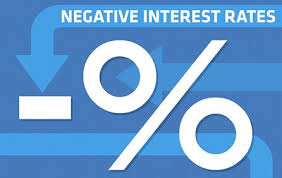 Sweden’s Central Bank, the Riksbank, rattled markets with a rate cut of .15%, now at -0.50%. Bank shares plunged again. Société Générale is down 13%, Deutsche Bank 7%, and Santander 6%.
Sweden’s Central Bank, the Riksbank, rattled markets with a rate cut of .15%, now at -0.50%. Bank shares plunged again. Société Générale is down 13%, Deutsche Bank 7%, and Santander 6%.
US treasury yields are falling like a rock with gold flying high, up another $40. Oil fell towards $26, and US futures are at the lowest price in two years.
Despite the fact that negative rates cripple bank stocks and rob savers, cutting rates is the only damn thing many of these central banks know how to do.
Please consider Riksbank Cuts Rates Deeper Into Negative Territory.
Sweden’s central bank moved its interest rates deeper into negative territory with an unexpectedly large cut, intensifying fears that global policymakers are being forced to take more extreme action to tackle low inflation.
The Riksbank cut its main repo rate by 15 basis points to minus 0.5 per cent, despite the fact that the country’s economy is booming. The bank said it felt forced to act because of “weakening confidence” in achieving its inflation target of 2 per cent.
The move rattled currency markets, sending the Swedish krona down 1.6 per cent against the euro, while the yen hit a 14-month high of 111.39 against the US dollar.
Bank shares resumed their slide, led by Société Générale, which tumbled as much as 13 per cent. Deutsche Bank dropped 7.1 per cent, Santander lost 6.1 per cent, and UniCredit sank 8 per cent. The pan-European Stoxx 600 fell 3.4 per cent, while US markets were called to open at their lowest in almost two years.
The Swedish cut followed the Bank of Japan’s decision to lower interest rates to minus 0.1 per cent in January, a move which stunned financial markets. At the meeting to approve the cut, some members of the BoJ’s policy committee warned of a global race with other central banks to set the lowest interest rates.
“Today’s action hints at the Riksbank’s willingness to forearm itself also from the ECB’s upcoming action expected in March,” noted Marco Valli, economist at Unicredit.
The ECB lowered its deposit rate to minus 0.3 per cent in December and is expected to make another cut of at least 10 bps at its meeting next month.
Sweden is in the unusual position of having very strong economic growth currently but weak inflation, causing an acute policy dilemma for the Riksbank. It forecasts that economic growth will be 3.5 per cent this year, a little lower than the 3.7 per cent in 2015.
But inflation was just 0.1 per cent in December while core inflation, more closely watched by the Riksbank, was 0.9 per cent.
The Riksbank has been open about its desire to keep the krona weak as part of a global battle to depreciate currencies. The central bank earlier this year delegated authority to its governor and one deputy governor to intervene in the currency markets at any time, a move that has spurred some concern among politicians in Stockholm and dissent from another deputy governor at the Riksbank.
Mind Boggling Stupidity
With economic growth at 3.5%, it would make more sense for the Riksbank to thank deflation than fight it. Spain’s growth is one of the best in the eurozone and Spain too is allegedly mired in deflation.
Next month, the ECB is likely to react with a cut sending its lending rate to -0.40 or -0.50%. Japan will feel forced to act in kind.
Meanwhile, the Yellen Fed still insists the Fed will hike rates this year. I suggest a global recession has begun.














